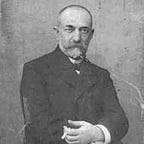The memex (a portmanteau of “memory” and “index“) is the name of the
hypothetical proto-hypertext system that Vannevar Bush described in his
1945 The Atlantic Monthly article “As We May Think“.
Memex is an electromechanical device enabling individuals to develop and read a large self-contained research library, create and follow associative series of links and personal annotations, and then recall them ready to share with other researchers. This device simulated the associative processes of the human mind.
The technology used would have been a combination of electromechanical controls, screen, microfilm cameras and readers, all integrated into a large desk.
“a sort of mechanized private file and library. It would use microfilm storage, dry photography, and analog computing to give postwar scholars access to a huge, indexed repository of knowledge — any section of which could be called up with a few keystrokes.”(Wardrip-Fruin, eds. 2003, The New Media Reader_ MIT)
Bush proposed a way to store information that was analogous to the mental association of the human brain: storing information with the capability of easy access at a later time using certain cues. (in this case, a series of numbers as a code to retrieve data).
The user could record new information on microfilm, by taking photos from paper or from a touch-sensitive translucent screen.
A user could “…insert a comment of his own, either linking it into the main trail or joining it by a side trail to a particular item. …Thus he builds a trail of his interest through the maze of materials available to him.” A user could also create a copy of an interesting trail (containing references and personal annotations) and “…pass it to his friend for insertion in his own memex, there to be linked into the more general trail.”
Tim Oren have pointed out, the memex could be considered to be a microfilm-based precursor to the personal computer.
The September 10, 1945, Life magazine article showed the first illustrations of what the memex desk could look like,
head-mounted camera, typewriter (plus voice recognition & speech synthesis)
“The office of the future”
“Given a memex, a scholar could create her own knowledge tools as connections within reams of information, share these tools, and use complexes of tools to create yet more sophisticated knowledge that could in turn be deployed toward this work. The memex has been envisioned as a means of turning an information explosion into a knowledge explosion. This remains one of the defining dreams of new media.” (Wardrip-Fruin, eds. 2003, The New Media Reader_ MIT)
This article is online available from The Atlantic Monthly magazine:
As We May Think: This article is online available from The Atlantic Monthly magazine:
There is an authorized reproduction in html and plain ascii format from the Saarland University (Germany):
This article is also reprinted in Literary Machines by Ted Nelson.
The MIT/Brown Vannevar Bush Symposium (Video Archives)
http://www.dougengelbart.org/events/vannevar-bush-symposium.html
This project, the Memex Simulator, examines the ideas of the Memex and implements them as faithfully to Doctor Bush’s original specifications as is possible given the small amount of information available on the as-of-yet unrealized physical design.
Originally published at www.aneddoticamagazine.com on July 10, 2015.
